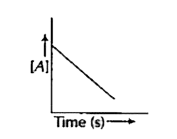The rate law for the reaction, cA+dB→mP+nQ is rate =k[A]c[B]d. What is the total order of the reaction?Solution in Odia
(x+y)
(m+n)
(c+d)
xy
The correct Answer is:C
Order is the sum of the powers to which the concentration terms are raised in the rate equation. Hence, order is (c+d).
Topper's Solved these Questions
- BOOK - ARIHANT PUBLICATIONCHAPTER - SAMPLE PAPER 1 EXERCISE - GROUP A7videos
SAMPLE PAPER 1
- BOOK - ARIHANT PUBLICATIONCHAPTER - SAMPLE PAPER 1 EXERCISE - GROUP B23videos
SAMPLE PAPER 1
- BOOK - ARIHANT PUBLICATIONCHAPTER - QUESTION PAPER 2019EXERCISE - GROUP C11videos
QUESTION PAPER 2019
- BOOK - ARIHANT PUBLICATIONCHAPTER - SAMPLE PAPER 4 EXERCISE - GROUP C7videos
SAMPLE PAPER 4
Similar Questions
Which noble gas is used in atomic reactor ?
01:31View SolutionBenzaldehyde can be obtained from benzal chloride. Write the reactions for obtaining benzal chloride and then benzaldehyde from it.
View SolutionWhat are oil in water and water in oil type of emulsions ? Give one example of cach type.
01:27View SolutionConsider the reaction, Ak−−→P. The change in the concentration of A with time is shown in the following plot:

(a) Derive the expression for the time required for the completion of the reaction.
(b) Predict the order of the reaction.01:31View SolutionThe rate of law for the reaction xA+yB=mP+nQ is Rate k[A]c[B]d. What is the total order of reaction ?
02:13View SolutionThe reaction, A + 2B to C +D obeys rate equation, Rate = k[A]^(x)[B]^(y) What would be the order of the reaction?
05:22View Solution(a) For a reaction , A+B rarr Product the rate law is given rate = k[A]^(1)[B]^(2) .What is the order of the reaction ? (b) write the unit of rate constant k for the first order reaction
02:42View SolutionThe rate law for the reaction x A + y B to mP + nQ is Rate = k[A]^(c) [D]^(d) . What is the total order of the reaction
02:58View SolutionThe rate law for a reaction A + B to C + D is given by the expression k[A]. The rate of reaction will be
02:39View SolutionReaction: A+2B to D follows the rate law: Rate = k[A][B]^(2//3) . The total order and unit of k will be :
01:48View Solutionक्रिया के लिये दर नियम
xA+yB→mP+nQ की दर =k[A]c[B]d है क्रिया की कुल कोटि क्या है01:24View Solution(a) For a reaction , A+B rarr Product the rate law is given rate = k[A]^(1)[B]^(2) .What is the order of the reaction ? (b) write the unit of rate constant k for the first order reaction
01:35View SolutionThe rate law for a reaction A+B→C+D is given by the expression k[A]. The rate of reaction will be
04:07View SolutionThe reaction A+ 2B to C + D obeys the rate equation, Rate = k[A]^x[B]^y what would be the order of the reaction?
02:42View SolutionThe reaction A+2B→C obeys the rate equationrate=k[A]^0.5[B]^1.5 what is the order of the reaction?
01:35View SolutionThe rate law of the reaction, 2A+B→2AC is represented as Rate =K[A]2[B]. If A is taken in large excess, the order of the reaction will be,
View Solution
